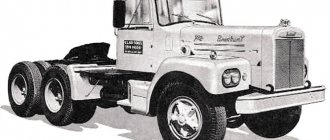A tachograph is a device that makes it easier to control a car. It connects to all vehicle systems and records its actions to provide information about the driver's actions and whether he was involved/not involved in the accident. The data can be retrieved by providing a special map. Let's figure out who needs such a device and how to install it.
The legislative framework
On February 27, 2014, the procedure for equipping commercial vehicles with tachographs was approved. The Ministry of Justice of the Russian Federation registered an order of the Ministry of Transport on the conditions for equipping vehicles with tachographs.
According to this order, some vehicles must now use digital tachographs with cryptographic data protection (CIPF module), which record information about work time, rest time, route, etc. continuously and in an unregulated manner.
The installation of tachographs with CIPF modules was carried out in several stages. From 1 April 2014, tachographs with CIPF modules were required to be installed on trucks transporting dangerous goods; from July 1, 2014 (the deadline was moved from April to July) - on buses and trucks with a gross weight of more than 15 tons; from September 1, 2014 - on trucks with a gross weight of more than 12 tons; from April 1, 2015 - for trucks with a gross weight from 3.5 to 12 tons.
However, for those who previously installed old-style tachographs, the deadline for mandatory equipment of vehicles with new tachographs was postponed to January 1, 2022.
Today, an explanation of the 2022 law on tachographs can be found in almost any information source. However, to obtain high-quality information without distortion, it is advisable to contact service centers that install tachographs and service them; only specialists will be able to provide you with up-to-date data.
Find out more about tachograph laws here.
What is a tachograph and what is it used for?
A tachograph is a device that measures a number of parameters of a car, the end result of which is the chronology of the driver’s working day: how long he was on the road, at what speed he moved, distance traveled, how much he rested, short breaks, non-stop sections of the journey, etc.
Based on the data received, the relevant authorities may file a violation of labor laws. But in this context, we are interested in the very need to install a tachograph, and, accordingly, punishment for the lack of a device.
The following photo shows what the tachograph looks like:
Who needs a tachograph and who doesn't?
What cars are equipped with a tachograph? It is installed on machines:
- which are used for intercity passenger transportation (if there are more than eight passenger seats);
- weighing more than 3500 kg, which also carry out intercity commercial cargo transportation.
Those. By law, the owner of a car may not install a tachograph on it if he is not engaged in commercial cargo transportation.
There are two different types of tachograph - digital and analogue. All commercial vehicles first registered on or after 1 May 2006 must be fitted with a digital tachograph.
A Russian directive has been issued to update tachographs to have GPS technology allowing authorities to remotely access stored information.
That is, a digital tachograph is needed.
Where to check tachograph fines
Like other car fines, tachograph fines can be checked:
- On the State Services portal;
- If the decision was made by the traffic police inspector, then on the traffic police website;
- If UGADN - then on the Rostransnadzor website;
- Through special sites and applications, such as Online Traffic Police
What difficulties might a fleet employee encounter here?
1. Enter information for each machine separately, which is quite labor-intensive: each site has a set of details necessary for verification. As a rule, these can be:
- resolution number;
- vehicle registration details;
- driver's license number;
- TIN of the organization.
2. The second difficulty is that inspections must be regular - fines can appear on any day.
Checking a large number of machines requires a lot of time and care, because... a mistake costs the company money (missing the period for payment with a 50% discount or blocking the current account by bailiffs).
Installation of a tachograph on a bus by law in 2022
According to the latest version of the vehicle safety regulations, a tachograph must be installed on cars of categories M2 and M3, which are used to transport passengers. Similarly, a tachograph on a bus is needed for commercial transportation outside the city, as well as school and duty shift buses.
If you are interested in the question of whether a tachograph is needed on a bus transporting company employees, then here you also need to refer to the legislation. When the vehicle is used to transport less than 8 passengers, then installation of the device is not required. And if you need a large bus, you will have to spend money on a tachograph.
Will tachographs be abolished until 2022?
Among drivers you can often hear the opinion that tachographs have been canceled until 2022 or 2022. Apparently, this is due to unverified publications in the media. Currently, the installation of tachographs is mandatory, and all exceptions are listed within the scope of this article.
If you still have questions about installing a tachograph on vehicles, then in addition I recommend studying the following instructions:
Do I need to install a tachograph - instructions
Good luck on the roads!
What does the law say about tachographs for commercial vehicles in 2022?
In a truck, a tachograph is needed to preserve the health and life of road users and to reduce the number of road accidents by registering and recording the speed limit, average speed and periods of work of drivers. With the help of a tachograph, it becomes possible to stop both violations of the speed limit by vehicle drivers and excessive fatigue of crew members, normalizing their work and rest time.
Among the main categories of vehicles, we can note the mandatory installation of tachographs on trucks:
1Weighing from 3.5 to 12 tons, used in commercial transportation.
2International freight transport.
3Buses with 8 or more seats.
Is it necessary to install tachographs on vehicles such as a dump truck or minibus? Let's look at this issue in more detail.
Installation of a tachograph on a dump truck when using it for personal purposes is not required. If the vehicle was purchased for commercial activity, installation is required. And if you are interested in the equipment of the cranes, then based on Orders of the Ministry of Transport No. 36 and 273, all cars equipped with a crane-manipulator must be equipped with tachographs.
Which cars do not need to install tachographs:
1Suburban, city buses, city minibuses.
2Truck cranes.
3Cargo GAZelles weighing less than 3.5 tons.
Some people are interested in the question of whether a tachograph is needed at Valdai. Let's figure it out. The Valdai medium-tonnage truck has a total weight of more than 6 tons, and a rated load capacity of more than 2 tons. According to the law, a tachograph must be installed on a vehicle weighing over 3.5 tons, which means that Valdai also requires the installation of a tachograph.
Do you need a tachograph for a 5 ton personal truck? In this case, the bill focuses on the nature of the vehicle owner’s activities. When the owner of the car is a legal entity or individual entrepreneur, installation is required. If not, then no. When checking, the absence of a flight recorder may arouse suspicion among traffic police officers. To protect yourself, you need to have documents with you confirming that you are not using your truck for the purpose of carrying out commercial activities.
How to connect an autotachograph?
To do this, you must contact workshops specifically approved by the Ministry of Transport to perform this operation.
Self-assembly or installation in unspecified services is equivalent to incorrect configuration or the absence of a tachograph.
List of tachograph installation workshops approved by the Ministry of Transport
This list is very dynamic - services are constantly being added, some, on the contrary, lose the right to install. Therefore, there is no point in indicating exact names here. It would be more correct to redirect readers to the appropriate page of the Ministry of Transport, where registers of certified workshops are published.
Do you need a driver's card?
According to the law, for a vehicle equipped with a digital tachograph and driven in accordance with the rules of the Russian Federation, the driver must have a driver card. If a driver who has been issued a driver card is asked to produce his card during a road inspection and fails to do so, even if he is simply driving a vehicle equipped with analogue tachographs, he commits an offence.
You can only have one driver card and you should never use someone else's card!
Rules for using a tachograph for drivers
All that is required from the driver (if he is not also the owner of the vehicle) is to check that the device is turned on and comply with traffic regulations. The rest (settings, verification, installation, etc.) lies on the shoulders of the car owner.
We'll tell you how to use the card. To turn it on, before starting to move, the truck driver must:
- Insert the driver card into the special slot of the tachograph.
- Enter your PIN code.
- Check the registration information on the screen (full name, etc.).
- Select the type of activity: rest or work. In some devices, the “operation” mode is turned on automatically when the engine starts, and is saved, incl. when parked with the engine running.
At the end of the shift, the driver card must be removed from the device.
Work and rest schedule for truck drivers in Russia according to tachograph
Legal requirements:
1You can drive no more than 9 hours a day. An extension of up to a maximum of 10 hours is permissible no more than twice in one week.
2Driving limit per week is 56 hours.
3But the general limit for two weeks is no more than 90 hours.
4If the rest time has not come, and the driver has been driving for more than 4 hours, you can take a break for 45 minutes.
5This pause may be replaced by a break of at least 15 minutes, followed by a pause of at least half an hour. During pauses, you cannot perform other work.
6Points 4 and 5 should not be considered as a daily rest period.
7 The daily duration of general work, including driving a vehicle, should not exceed 13 hours. General work can be extended to 15 hours a day. A driver may have a maximum of 3 working days, which he has extended up to 15 hours of total work between any two weekly rest periods.
8The maximum duration of continuous non-essential work and driving should not exceed six hours, after which the driver must pause for at least 45 minutes, unless it is time to rest.
9You must follow the rules and not deviate from them.
10You need to rest at least 11 hours per day. You can relax right in the car if there is a specially equipped place for rest.
Who has the right to check the tachograph on a truck on a flight? According to the law, there is only one option - a traffic police inspector (also a traffic police officer), which is approved by order number 5 of the Russian Ministry of Transport.
Which cars do not require tachographs?
Please note that there is a list of exceptions, i.e. buses and trucks that do not need tachographs:
- Trolleybuses;
- Cars carrying out international transportation and equipped with “European standard” tachographs;
- Military vehicles;
- Cars of bodies carrying out operational investigative activities (police, FSB, FSIN, etc.);
- Vehicles registered with state technical supervision (tractors and self-propelled vehicles);
- Vehicles over 30 years old that are not intended for commercial transportation (for which a recycling fee is not paid);
- Training vehicles not used for commercial transport;
- Cars undergoing road tests.
Please note that earlier this list also included buses providing regular urban and suburban services. However, from November 20, 2022
these vehicles are not included in the exclusion list.
In addition to the vehicles listed above, there is another list of exceptions
(by type of work performed):
- Truck-mounted concrete pumps;
- Truck mixers;
- Asphalt distributors;
- Truck cranes;
- Ambulances;
- Tow trucks;
- Fire trucks;
- Vehicles for public utilities and road maintenance;
- Vehicles for servicing oil and gas wells;
- Collection vehicles (for transporting money and valuable goods);
- Vehicles equipped with lifts with working platforms;
- Medical complexes on vehicle chassis;
- Auto shops;
- Buses for funeral services;
- Car-homes;
- Armored vehicles;
- Specialized vehicles (specially equipped milk tankers, livestock tankers, vehicles for transporting poultry, eggs, live fish, machines for transporting and applying mineral fertilizers);
- Category C trucks used by agricultural producers for on-farm transportation (transportation within the boundaries of the municipal district in which the vehicles are registered, as well as municipal districts bordering it);
- Special vehicles;
- Mobile laboratories and workshops;
- Mobile television studios.
This list includes many specialized vehicles. There is no need to install tachographs on them and this will not entail a fine.
What should you do if an unexpected event occurs under driver watch rules?
In order for the driver to reach a safe stopping point and ensure the safety of other people, the vehicle or the cargo, deviations from the rules of the Russian Federation may be permissible if this does not jeopardize road safety.
A 1995 European Court decision states that derogation only applies in cases where it is impossible to comply with the rules regarding drivers' watches. In the event that this occurs, drivers must note the reasons why they deviated from the rules, either on the back of their tachograph record sheets if they are using an analog tachograph, or on a printout or time sheet if using a digital tachograph once they have reached the correct location stops.
Checking tachograph fines through the Online Traffic Police service
Online traffic police replaces the manual search for fines on government websites. authorities for automatic verification against the federal treasury database. It contains information about all fines for legal entities and individuals. All cars and drivers of the company are checked simultaneously. The report is generated in your personal account.
How the automated fine control service works:
- Monitors the appearance of new fines in the fleet - traffic police, MADI, AMPP, Platon for each car and driver;
- Notifies the organization about each fine that appears by email or SMS, as well as in your personal account;
- Generates documents for payment (receipts, payment orders) or automatically pays off fines (when the option is activated).
- Tracks payment results in the Federal Treasury GIS GMP database and displays them in your personal account;
- Identifies partially paid orders that cannot be found by standard means;
- Saves the history of all fines for each car;
- Notifies the FSSP of enforcement proceedings on overdue fines and provides details for payment;
- Prepares a detailed report on outstanding fines;
- Integrates with the automated control system of organizations that record fines in an accounting system (for example, 1C).
The service makes it possible to manage fines using buttons in your personal account - just like on a control panel. This frees up time for other important tasks.
Check the work of the Online Traffic Police
Payment deadlines are always under control - you always have time to pay fines with a 50% discount and spend money for the development of the company, and not on fines.
Important changes in legislation
Even knowing which cars need a tachograph, you need to monitor changes in the regulatory framework and respond to them in a timely manner. The most relevant as of mid-2021 will be:
- Changes to the inspection rules that came into force on 03/1/21. According to these changes, if a tachograph is to be installed on a vehicle, the device must undergo verification/adjustment and print service information.
- Order of the Ministry of Transport of the Russian Federation No. 440 dated October 28, 2020. The order replaced the expired order No. 36 dated February 13, 2013 and contains information on the requirements for tachographs installed on vehicles.
- Updated requirements regarding licensing of passenger transportation (from 1.01.21). According to these requirements, buses must be equipped with digital tachographs, as well as GLONASS/GPS positioning equipment.
By monitoring these changes and responding to them in a timely manner, you can avoid fines and continue operating in the field of freight or passenger transportation in full compliance with the laws of the Russian Federation.
Do individuals need a tachograph?
Many people are concerned about the question of what awaits a private person who owns a vehicle that falls under the criteria for being equipped with a tachograph?
Situation 1. If a person using a personal vehicle is engaged in commercial activities involving the transportation of goods or passengers, then the answer is yes, a tachograph is required.
As soon as possible, it is necessary to equip the car with a control device, purchase a driver card for the tachograph and observe the operating mode.
Situation 2. If the transport is used exclusively for one’s own needs (for example, transporting building materials to the country), then a tachograph is not installed.
To avoid questions when checking by a traffic police officer, all transported goods must have accompanying documents (invoices, sales and cash receipts) issued to the truck driver.
And to avoid problems with passenger transportation in personal minibuses, our experts advise converting the vehicle into 8 seats.
We remind you that from June 29, 2022, to transport people on buses (with a capacity of more than 8 seats), both for commercial purposes and simply for personal acquaintances, a license for this type of activity is required.
Our legal experts will help you weigh and evaluate all the circumstances in each specific case, as well as make the right decision and avoid problems with the law. Online consultations are provided free of charge.
Replacing an analogue tachograph with a digital model
Previously, it was possible to use old-style analog/puck tachographs on vehicles. They stopped installing such equipment quite a long time ago due to the low accuracy of mileage recording, as well as ineffectiveness in protecting data from changes. But some machines had such devices - and they could be used.
Starting from March 2022, the operation of analogue tachographs in the Russian Federation is prohibited by law. This means that the machine on which the puck recorder is installed must be urgently re-equipped with a modern digital model:
- With CIPF block - for domestic flights.
- AETR - for flights abroad.
Note! In the Russian Federation, only equipment included in the approved list can be used. The list of tachographs that can be installed on vehicles includes models such as SHTRIKH-TachoRUS, KASBI DT-20M, Mercury TA-001, ATOL Drive 5 and some others. None of the analog devices are included in this list, therefore devices of this type must be replaced.
Time frames for equipping various vehicles with tachographs with cryptographic information protection
- Until 1.04.14 - Vehicles for the transportation of dangerous goods
- Until 1.06.14 - buses (exception - buses on suburban and city routes).
- Until 1.07.14 - trucks whose weight exceeds 15,000 kg, involved in intercity transportation
- Until 1.09.14 - trucks whose weight exceeds 12,000 kg.
- Until 1.04.15 - trucks whose weight exceeds 3500 kg.
- Before 06/01/16 - equipment on which analogue type recorders were previously installed.
- Before 01/01/18 - equipment on which digital type recorders without a CIPF module were previously installed.
- Until June 1, 2018 - buses that operate on suburban routes.
- Until July 1, 2021 - buses on city routes.
Thus, today all the deadlines allowed for the re-equipment of vehicles have passed - and vehicles must have tachographs with CIPF or AETR.
What is the relevance of this material?
Of course, tachography legislation changes regularly. The topic is relatively new for Russia and is just developing. In this regard, the deadlines for equipping tachographs for various categories of vehicles are often changed (postponed). The list of exceptions is also constantly shrinking - who doesn’t need to get a tachograph! The policy is structured in such a way as to systematically and gradually equip all commercial types of vehicles with devices for monitoring work and rest schedules. If you want to receive objective and up-to-date information on the questions of who needs to install a tachograph and who does not need to install one, we recommend that you save the link to this article. We will constantly monitor innovations in regulatory documents and regularly update the material on this page.
Relevance of the material at the moment: February 2020.
up to content
Who has the right to check the tachograph?
Transport compliance with new requirements is carried out by the following regulatory authorities:
- State traffic inspectorate, namely traffic police inspectors on the road;
- Rostransnadzor, on-site inspections by UGADN inspectors;
- Federal Customs Service (for international carriers).
Not only the presence of a tachograph will be checked, but also:
- compliance with the device model;
- its serviceability;
- calibration and sealing;
- entry into the register of Federal Budgetary Institution Rosavtotrans;
- driver card for tachograph;
- printout of data from the tachograph about the actual operating mode of the driver in transport.










